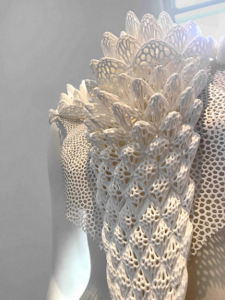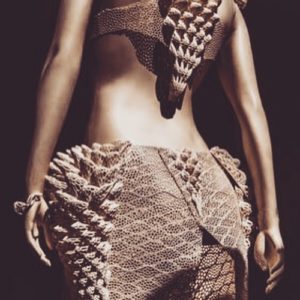Designer Uses Sustainable 3D Printing in Recent Exhibition Blurring the Lines Between Fashion and Art
 My wedding dress was so beautiful, I was almost afraid to touch it, much less wear it. Have you ever seen a piece of clothing, or jewelry, and thought that it was so striking it was an actual work of art? Thanks to innovative 3D printing technology, it’s not uncommon these days to see unique pieces of fashion that are so intricate and complex they almost belong in a museum.
My wedding dress was so beautiful, I was almost afraid to touch it, much less wear it. Have you ever seen a piece of clothing, or jewelry, and thought that it was so striking it was an actual work of art? Thanks to innovative 3D printing technology, it’s not uncommon these days to see unique pieces of fashion that are so intricate and complex they almost belong in a museum.
Italian designer Simone Leonelli, with the W230studio in Perth, West Australia, often uses 3D printing to make his pieces. Last month, Leonelli had a 3D printed fashion exhibition on display at the Perth Institute of Contemporary Arts (PICA) as part of the Telstra Perth Fashion Festival that blurred the lines between fashion and art.
“It is a ‘Fashion Total Look’ made by a desktop 3D Printer in order to push the boundaries of this process,” Leonelli told 3DPrint.com. “To summarise, this project is an exploration of fashion through the use of computational design and high-tech tools. In this instance, the fashion objects should be understood as architecture or as a design experiment.”
 The 3D printed fashion pieces – including shoes, a dress, and a bag – in the futuristic “Blurred Boundaries” exhibition were fabricated on an FDM desktop 3D printer, so that Leonelli could really “push the boundaries of open source tools.”
The 3D printed fashion pieces – including shoes, a dress, and a bag – in the futuristic “Blurred Boundaries” exhibition were fabricated on an FDM desktop 3D printer, so that Leonelli could really “push the boundaries of open source tools.”
Leonelli told Perth Underground, “The pieces on display resemble cell skeletons like Radiolarians and Diatoms; it just reminds you the beauty of the sea.”
The designer used both hardware and software to turn his unique design goals into reality. Rather than actual pieces of clothing a person could feasibly wear, he explained that the designs “should be understood as architecture or as a design experiment.”
“The designs have been inspired by biological structures such as mineral cell skeletons, and the complexities were created with the help of computational design processes,” Leonelli told us. “The forms are not driven by imitating nature specifically, instead they are human interpretation of the way in which nature designs itself.”
 The exhibition as a whole is an exploration of biological structures, fashion, and technology. Leonelli used biodegradable PLA material, a bioactive and renewable thermoplastic, for most of the 3D printed parts, due to his passion for sustainable design.
The exhibition as a whole is an exploration of biological structures, fashion, and technology. Leonelli used biodegradable PLA material, a bioactive and renewable thermoplastic, for most of the 3D printed parts, due to his passion for sustainable design.
“The potential of 3D printing is incredible, and when combined with the power of computational design the user will experience a very flexible and scalable technology,” Leonelli explained to 3DPrint.com.
He said that if he had used traditional methods of manufacturing, like milling or injection molding, instead of 3D printing, he would not have been able to produce the complex, non-standard shapes he was looking for.
“The beauty of working with these high-tech tools is the possibility of working without following a standard workflow or hierarchy. You can for example, create a design using the whole or part of the human body, and move back and forth through the workflow with 3D scansion,” Leonelli told us.
“You can even jump from one part of the workflow timeline to another with a great deal of flexibility and degrees freedom. 3D print manufacturing makes creative ideas simple to produce. It is currently one of the most efficient ways to transform design ideas into products.”
During Leonelli’s free exhibition last month, PICA’s education program, Spark_Lab, also set up some simple activities related to “Blurred Boundaries” so younger visitors would be able to appreciate the exhibition while also stimulating their curiosity and their creativity.
https://www.facebook.com/W230store/videos/1850098591681838/
[Images provided by Simone Leonelli]What do you think of the exhibition? Discuss this and other 3D printing topics at 3DPrintBoard.com, or share your thoughts in the Facebook comments below.
Subscribe to Our Email Newsletter
Stay up-to-date on all the latest news from the 3D printing industry and receive information and offers from third party vendors.
You May Also Like
3D Printed Heat Spreader Could Improve Efficiency of Electronics
The low-hanging fruit for decarbonization has long been improving the efficiency of existing systems, hence the justification for LED lights and ENERGY STAR certified appliances. While such minor moves are...
3D Printing News Unpeeled: Marine Gearboxes, 3D Printed Motors and $1.7 Million in Seed Funding
UK based Equipmake just released their Ampere-220 e-axle system. The system, which is meant for high performance electric cars, was similar to one released on the Ariel HIPERCAR. It has...
CEAD Unveils 36-Meter-Long 3D Printer for Abu Dhabi’s Al Seer Marine
CEAD, a Dutch original equipment manufacturer dedicated to large-format 3D printers, has unveiled what it claims to be the world’s largest robotic arm-based 3D printer. At 36 meters long and...
3D Printed Biocomposites Could Help Reduce Marine Plastic Pollution
Concerns about the impact of plastic litter and microplastics in the oceans are at the forefront of environmental study. For decades, the marine environment has suffered from the degradation of...







































